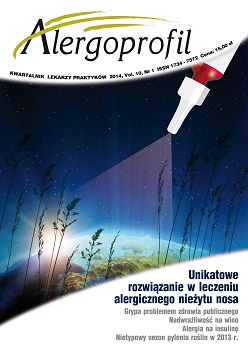Grypa problemem zdrowia publicznego. Co każdy wiedzieć powinien
##plugins.themes.bootstrap3.article.main##
Abstrakt
W naszej strefie klimatycznej obecny czas zimowo-wczesnowiosenny sprzyja rozprzestrzenianiu się infekcji górnych dróg oddechowych i grypy. Wielu twierdzi, że grypa wydaje się nietrudna do rozpoznania dzięki bardzo gwałtownie występującym i szybko narastającym objawom, takim jak: gorączka (zwykle powyżej 38oC), bóle mięśniowe, bóle głowy oraz uporczywy suchy kaszel. Jednak podobne dolegliwości mogą być spowodowane zakażeniem innymi wirusami. Należą do nich wirusy paragrypy, adenowirusy, rynowirusy itp. W sumie szacuje się, że ponad 200 patogenów może być odpowiedzialnych za objawy podobne do grypy. W razie potrzeby można u pacjenta wykonać diagnostykę wirusologiczną, czyli podjąć czynności mające na celu zdefiniowanie konkretnego czynnika chorobotwórczego znajdującego się w materiale pobranym w wymazach z górnych dróg oddechowych. Dawniej do tego celu służyły skomplikowane, czasochłonne, a przez to nieużyteczne w praktyce metody hodowli wirusów na kurzych zarodkach. Choć badania tego typu są ciągle wykonywane, to ustępują miejsca nowoczesnym technikom wykorzystującym zdobycze biologii molekularnej i inżynierii genetycznej, które pierwotnie były stosowane jedynie do badań naukowych, a obecnie znajdują już szerokie zastosowanie praktyczne. Praca ta opisuje podstawowe wiadomości dotyczące budowy wirusa grypy, jego diagnostyki, a także sposoby profilaktyki.
Pobrania
##plugins.themes.bootstrap3.article.details##
Copyright: © Medical Education sp. z o.o. This is an Open Access article distributed under the terms of the Attribution-NonCommercial 4.0 International (CC BY-NC 4.0). License (https://creativecommons.org/licenses/by-nc/4.0/), allowing third parties to copy and redistribute the material in any medium or format and to remix, transform, and build upon the material, provided the original work is properly cited and states its license.
Address reprint requests to: Medical Education, Marcin Kuźma (marcin.kuzma@mededu.pl)
Bibliografia
2. Wojtyniak B., Goryński P., Moskalewicz B. (red.) Sytuacja zdrowotna ludności Polski i jej uwarunkowania. Wyd. NIZP-PZH, Warszawa 2012.
3. Meldunek Zachorowania na wybrane choroby zakaźne w Polsce od 1 stycznia do 31 grudnia 2013 r. [online: http://www.pzh.gov.pl].
4. Centers for Disease control and Prevention. Prevention and control influenza. Recomendations of the Advisory Committee on Immunization Practices (ACIP). MMWR 2005, 54: 1-31.
5. van Essen G.A., Palache A.M., Forleo E. et al.: Influenza vaccination in 2000: recommendations and vaccine use in 50 developed and rapidly developing countries. Vaccine 2003, 21(16): 1780-1785.
6. Stanisz B.: Terapia grypy. Teoria i Praktyka 2009, 65(1): 9-14.
7. Webster R.G., Bean W.J., Gorman O.T. et al.: Evolution and ecology of influenza A viruses. Microbiol. Rev. 1992, 56(1): 152-179.
8. Murphy B.R., Webster R.G.: Orthomyxovirueses in Fields Virology (Ed). Raven, New York 1996: 1397-1445.
9. Cox N., Subbarao K.: Global epidemiology of influenza: past and present. Ann. Rev. Med. 2000, 51: 407-421.
10. Wilson I.A., Cox J.A.: Structural basis of immune recognition of influenza virus hemagglutynin. Annu. Rev. Immunol. 1990, 8: 737-771.
11. Brydak L.B., Woźniak-Kosek A., Nitsch-Osuch A.: Influenza vaccines and vaccinations in Poland – past, present and future. Med. Sci. Monit. 2012, 18(11): 166-171.
12. Virella G.: Mikrobiologia i choroby zakaźne. W: Wirusy RNA. Manos J. (tłum. Piotrowska E.) Wyd. I. Urban&Partner, Wrocław 1999: 339-342.
13. Zając M., Pawełczyk E., Jelińska A.: Chemia leków. W: Leki przeciwwirusowe. Wyd. II. Akademia Medyczna, Poznań 2006: 527-539.
14. Cox N.J., Subbarao K.: Influenza. Lancet 1999, 354: 1277-1282.
15. Webster R.G.: Immunity of influenza in the elderly. Vaccine 2000, 18: 1686-1689.
16. Fong S.K.Y., Lee M.K., Griffith B.P.: Evaluation of R-Mix fresh cells in shell vials for detection of respiratory viruses. J. Clin. Microbiol. 2000, 38: 4660-4662.
17. Grubek-Jaworska H.: Współczesne możliwości diagnostyczne zakażeń układu oddechowego. Int. Rev. Allergol. Clin. Immunol. Family Med. 2012, 18 (13): 127-134.
18. Espy M.J., Uhl J.R., Sloan L.M. et al.: Real-Time PCR in clinical Microbiology: Applications for Routine Laboratory Testing. Clin. Microbiol. Rev. 2006, 19: 165-256.
19. Greiner O., Day P.J., Bosshard P.P. et al.: Quantitative detection of Streptococcus pneumoniae in nasopharyngeal secretions by real-time PCR. J. Clin. Microbiol. 2001, 39: 1162-1170.
20. Grant W.: Observation on the late influenza the febris catarrhalis epidemica of Hippokrates as it appeared in 1775 and 1782. London 1782: 4.
21. Templeton K.E., Schellinga S.A., Beersma M.F.: Rapie and Sensitive Metod Using Multiplex Real-Time PCR for Diagnosis of Infections by Influenza A and Influenza B Viruses, Respiratory Syncytial Virus, and Parainfluenza Viruses 1, 2, 3. J. Clin Microbiol. 2004, 42: 1564-1569.
22. Degelau J., Somani S.K., Cooper S.L. et al.: Amantadine resistant influenza a in a nursing facility. Arch. Intern. Med. 1992, 152: 390-392.
23. Hayden F.G., Belshe R.B., Clover R.D. et al.: Emergence and apparent transmission of rimantadine-resistant influenza a virus in familie. N. Engl. J. Med. 1989, 321: 1696-1702.
24. Dolin R., Reichman R.C., Madore H.P. et al.: Controlled trial of amantadine and rimantadine in the prophylaxis of influenza A infection. N. Engl. J. Med. 1982, 307: 580-584.
25. Hayden F.G., Gwaltney J.M., van de Castle R.L. et al.: Comparative toxicity of amantadine hydrochloride and rimantadine hydrochloride in health adults. Antimicrob. Agents Chemother. 1981, 19: 226-233.
26. Hayden F.G., Atmar R.I., Schilling M. et al.: Use of the selective oral neuraminidase inhibitor oseltamivir to prevent influenza. N. Engl. J. Med. 1999, 341: 1336-1346.
27. Nicholson K.G., Aoki F.Y., Osterhaus A.D. et al.: Efficacy and safety of oseltamivir in treatment of acute influenza: randomized controlled trial. The Lancet 2000, 355: 1845-1850.
28. Osterhaus A.D., de Jong J.C.: The control of influenza: antivirals as an adjunct to vaccines. Vaccine 2000, 18: 779-780.
29. Portal internetowy Szczepienia info [online: szczepienia.pzh.gov.pl].
30. Dziennik Urzędowy Ministra Zdrowia z dnia 31.10.2013 r., poz. 42. Załącznik do Komunikatu Głównego Inspektora Sanitarnego w sprawie Programu Szczepień Ochronnych na 2014 r.
31. Wytyczne Kolegium Lekarzy Rodzinnych w Polsce. Profilaktyka i Leczenie Grypy 2006. Wyd. Aktis, Łódź 2006: 1-40.
32. Prevention and control of influenza. Morbidity and Mortality Weekly Report 1997, 46: 1-25.

